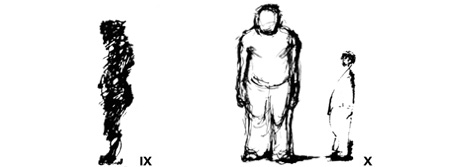Congenital predominance of the central osei: inward-outward taiheki, types nine and ten
When the central osei + (IX) is predominant by taiheki, the following physical structure is formed:
Everything is compact, dense and small. The formation of the pelvis stands out. Very large protruding buttocks. The head is not very big and it is bulky behind the ears. The neck is thick and strong and the cervical curve is very pronounced. The neck sinks into the trunk pulling the head downward from its posterior- inferior area (similar to a turtle drawing its head into its shell). The overall CVP is triangle-shaped (large hip, compact shoulders and head) and the curves of the spinal column are very pronounced. At the waist, the lumbar vertebra 4 usually sits in a more forward position than in the other oseis (it occupies the place usually taken by lumbar 3). The limbs are compact. The femur is long. The ankles are very strong. The hands and the feet are small.
This structure is activated from the ventral area (this is the only exception among types +) as a result of the A tension that is channelled through it. This A tension activates, among other tissues, the central series of muscles connected to the psoas minor, the transversus abdominis, and the fascia (muscular connective tissue) in relation to the paravertebral muscles. This activation triggers fast inner vibrations.
The structure of the central osei – (X) predominant by taiheki is as follows:
Everything is wide, dense (although not as dense as in osei IX), and big. The formation of the pelvis, which is very big and wide, stands out. The head is also big (although this cannot be easily observed due to the size of the pelvis). The neck is very thick but it lacks muscular strength. The shoulders are wide and they also lack muscular strength. The overall CVP is also very wide (this is the main cause of obesity when it appears). The extremities, the hands, and the feet, are also big but their tendons are not strong. The ankles are weak and they usually twist. Except for the latter, the nature of this structure is strong and it does not suffer from frequent mild illnesses or disorders.
The structure of osei X is activated from the dorsal area (this is different from the other taihekis –) as a result of the A tension that is channelled through it. This A tension activates, among other tissues, the same series of central muscles as those in osei IX connected to the latissimus dorsi and to the fascia.

predominance of the central osei + predominance of the central osei –
The strength inherent in this type of human nature, oseis IX and X, decreases when the sexual drive cannot be fulfilled or when one’s self-confidence is lost as a result of the inhibition of the affective psyche. As a consequence, the type of excessive partial tension that arises shows the following characteristics:
- the tissues organized around vertebrae C6, Th11 and L4 get stiff and lax; this is the source some pain in the vertebral column;
- a knot at the centre of the pit of the stomach which reduces the chest-abdominal breathing;
- tumours and cancer (caused, among all, by the over-excitation of the connective cells, although this might not be the only cause);
- asthma (which leads directly to shortness of breath);
- impotence related to some complex.
At the psychic level, different obsessions can be observed:
- complex, phobia or obsession caught by an internal over-excitation of some brain activity focussed on the absolute or eternal union with one’s closest people;
- obsession in egocentrism or hatred (predominant IX) and lack of capacity to concentrate on something or dispersion (predominant X).


